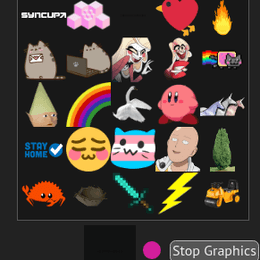SPF420 x SYNC^UP

Originally, I was working with a group of people to help link up a set of three concerts taking places in different cities via live streams, allowing crowds from the different venues to see each other and feel connected with the online viewers. However, that got canceled due to COVID-19.
Instead, we teamed up with the people behind the online concert series SPF420, which had been on hiatus for several years, to put on a fully online concert. Since I'd already done a bit of work for the livestreaming component of the SYNC^UP project, I took up the task of adapting it to work with the new idea. Instead of sharing streams of crowds from different venues with each other, the goal became allowing multiple artists to stream themselves DJing and combine it with streams of visuals from VJs.
As luck would have it, I had a week off of work due to changing jobs and was also quarentined in my apartment, giving me a whole week to spend pretty much all on building out the setup for this concert. To see the result, check out the videos on Youtube:
The first concert was a massive success, and we have more planned. I'm still thinking about what kinds of changes or additions I want to add for the next iterations but am looking forward to being a part of the project as it continues to grow into the future.
Tech Stack
There were two main parts to the setup: the streaming architecture and the website + live interactive components. The livestream itself was hosted on Mixer and embedded into the webpage via an iframe.
Streaming Architecture
The streaming architecture for this project was quite complicated. The idea was simple: get a bunch of different artists streaming their audio and/or video to my server, combine it with other artists' audio/visuals dynamically, and relay the result to Mixer. However, due to a number of different hurdles and unexpected challenges, I ended up building an internal NodeJS and React app to manage routing streams and managing who's live, running an Ubuntu desktop instance inside Docker on a VM in the cloud, and even forking FFMPEG.
After everything was said and done, though, it worked quite well and all of the pieces worked well together to produce a dynamic and functional concert experience. I should write more about it at some point because it really is quite an impressive setup if I do say so myself.
Website, Chat, and Stickers
The main feature of this was a Rust websocket server that provided all of the functionality for the live chat, cursor trails, and stickers. It operated via protobufs over websocket allowing for the total bandwidth of the system to be kept as low as possible. The chat had built-in moderation capabilities, rate-limiting, and quality control (max username/message length, etc.). After a couple initial crashes and a hotfix due to Rust panicking when `.truncate()`ing a string in the middle of a Unicode codepoint, the server continued operating without issue for the whole event.
The main interactivity besides the chat was the ability to see mouse trails of all other users as they move their mice around the background, producing a sort of "rave glow stick" effect, as well as the ability to place down stickers in the background. It was really cool to see people coordinate their sticker-placing in response to different events in the concert, like spamming down Miku stickers in the "Miku Pit" in response to Miku making an appearance in one of the tracks.
One thing I'd like to look into is optimizing the performance of the stickers by using plain HTML images rather than rendering to a canvas. That way, instead of having to re-draw all of the hundreds of stickers every time anything happened, only changed images would need to be updated. Even without that optimization, however, performance seemed pretty good for most users and the site worked even on mobile devices.
